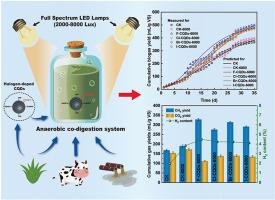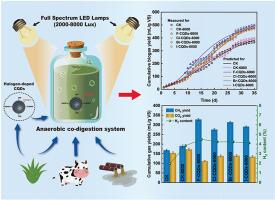Photo-responsive halogen-doped carbon quantum dots enhance anaerobic co-digestion: Focusing on biogas yield and electron transfer
IF 10
1区 环境科学与生态学
Q1 ENGINEERING, ENVIRONMENTAL
引用次数: 0
Abstract
Carbon quantum dots (CQDs) have been demonstrated to be effective accelerators in anaerobic co-digestion (AcoD) systems for enhancing digestion efficiency. Nevertheless, CQDs have greater potential when exposed to light illumination, and the synergistic interaction between CQDs and light in AcoD systems remains unexplored. In this study, different concentrations of halogen-doped CQDs (F/Cl/Br/I-CQDs) were added as accelerators to AcoD systems equipped with stationary illumination (2000–8000 Lux) to investigate the enhancing effects of halogen-doped CQDs on AcoD systems under light conditions. Four halogen-doped CQDs had different promotion effects on AcoD under 6000 Lux illumination, and F-CQDs showed the best promotion effect. The addition of F-CQDs (0.6 g/L) under 6000 Lux illumination greatly increased the biogas yield (541.2 mL/g VS), cumulative CH4 yield (374.4 mL/g VS), and the degradation rate of total chemical oxygen demand (TCOD) (64.6 %), compared to those of the control group (367.9 mL/g VS, 168.5 mL/g VS, 36.7 %). These excellent enhancements are attributed to the good electron transfer properties of the halogen-doped CQDs and synergistic effect of light illumination, which improves direct interspecies electron transfer (DIET) among microorganisms. Halogen-doped CQDs and light can facilitate the enrichment of key anaerobic microbial communities. This study proposes a novel strategy that integrates halogen-doped CQDs and light irradiation to enhance biodegradation by enhancing the DIET, offering a sustainable approach for optimizing waste-to-energy conversion in AcoD systems with improved biogas productivity.


光响应卤素掺杂碳量子点增强厌氧共消化:关注沼气产量和电子转移
碳量子点(CQDs)已被证明是厌氧共消化(AcoD)系统中有效的加速剂,可以提高消化效率。然而,当暴露在光照下时,CQDs具有更大的潜力,并且AcoD系统中CQDs与光之间的协同相互作用仍未被探索。本研究将不同浓度的卤素掺杂CQDs (F/Cl/Br/I-CQDs)作为加速剂加入到固定照明(2000-8000 Lux)的AcoD体系中,研究光照条件下卤素掺杂CQDs对AcoD体系的增强作用。在6000 Lux光照下,4种卤素掺杂CQDs对AcoD的促进效果不同,其中F-CQDs的促进效果最好。在6000 Lux光照条件下,与对照组(367.9 mL/g VS、168.5 mL/g VS、36.7%)相比,添加0.6 g/L的F-CQDs显著提高了生物气产率(541.2 mL/g VS)、累积CH4产率(374.4 mL/g VS)和总化学需氧量(TCOD)降解率(64.6%)。这些优异的增强归功于卤素掺杂CQDs良好的电子转移特性和光照的协同效应,从而改善了微生物之间的直接种间电子转移(DIET)。卤素掺杂CQDs和光可以促进关键厌氧微生物群落的富集。本研究提出了一种新的策略,将卤素掺杂CQDs和光照射结合起来,通过增强DIET来增强生物降解,为优化AcoD系统中的废物-能源转换提供了一种可持续的方法,提高了沼气生产率。
本文章由计算机程序翻译,如有差异,请以英文原文为准。
求助全文
约1分钟内获得全文
求助全文
来源期刊

Journal of Cleaner Production
环境科学-工程:环境
CiteScore
20.40
自引率
9.00%
发文量
4720
审稿时长
111 days
期刊介绍:
The Journal of Cleaner Production is an international, transdisciplinary journal that addresses and discusses theoretical and practical Cleaner Production, Environmental, and Sustainability issues. It aims to help societies become more sustainable by focusing on the concept of 'Cleaner Production', which aims at preventing waste production and increasing efficiencies in energy, water, resources, and human capital use. The journal serves as a platform for corporations, governments, education institutions, regions, and societies to engage in discussions and research related to Cleaner Production, environmental, and sustainability practices.
 求助内容:
求助内容: 应助结果提醒方式:
应助结果提醒方式:


